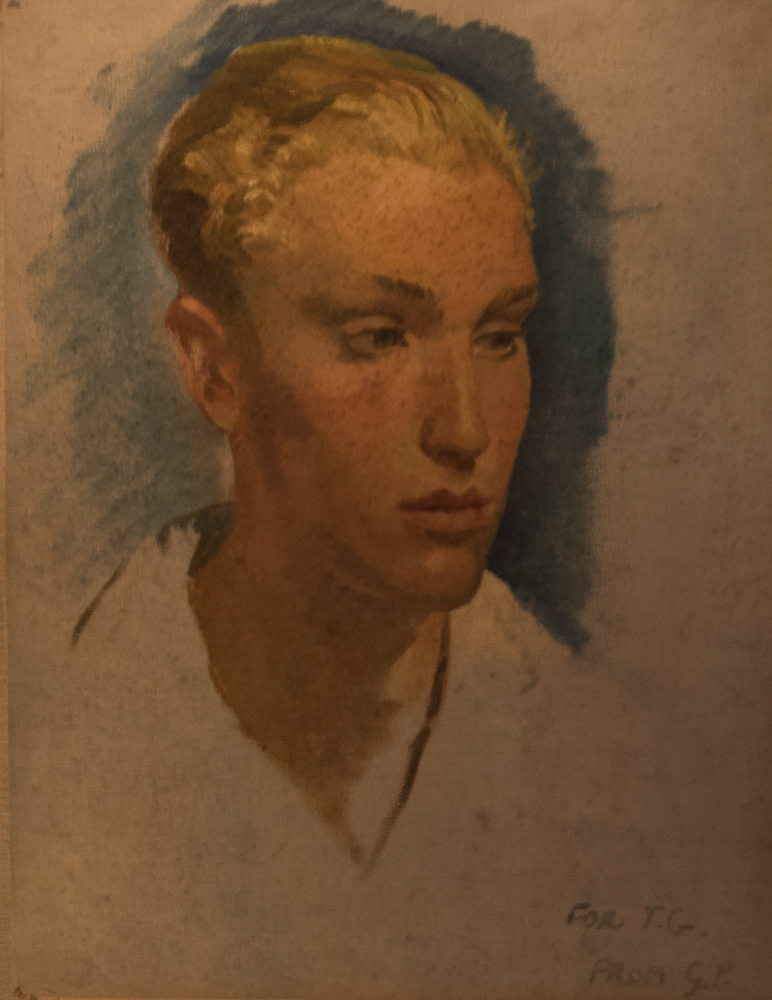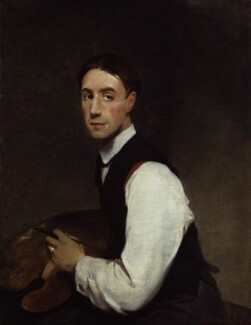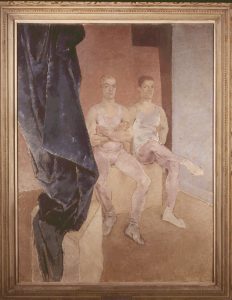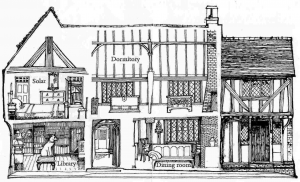Portrait of a Young Man by Glyn Warren Philpot (1884-1937)
In the Well Room at Little Hall, Lavenham, the former home of twins Robert and Thomas Gayer-Anderson, hangs a portrait of a young man by the artist Glyn Warren Philpot. The portrait, a gift to Thomas Gayer-Anderson from Philpot is undated but appears stylistically to be painted in the mid years of Philpot’s career. It is annotated “for TG from GP”, and was conceivably painted specifically for Thomas. The Museum catalogue assigns the date as 1932. The sitter is unknown but is conceivably the artist Vivian Forbes (1891-1937), Philpot’s student and lover.

oil on canvas, 1932
© SBPT.
It was Robert Gayer-Anderson who introduced Philpot and Forbes to his brother Thomas. He had first met the two men in Cairo in 1923 describing them as “delightful”. At the time Philpot was in the city to undertake a painting of Egypt’s ruler King Fouad. Over the ensuing years Philpot and Forbes would become frequent visitors to Little Hall, along with other artists, including Dod (Doris) and Ernest Procter, Eric Gill and Reginald Brill.
The twins would remain friends with Philpot and Forbes until 1937. In December that year Philpot died of a brain haemorrhage. Forbes, struck with grief, committed suicide shortly after the funeral in Westminster Cathedral. They left behind an adopted son.
Philpot studied at the Lambeth School of Art between 1900–03, and at the Académie Julian, Paris in 1905. The Académie was a somewhat more informal Parisian art institute than the prestigious École des Beaux-Arts and probably suited Philpot’s temperament. In choosing to study at the Académie Julian rather than the École des Beaux-Arts Philpot escaped the Beaux-Arts notoriously difficult French language examination.
In the early years of his career Philpot, a convert to Catholicism, painted allegories of religious subjects for which he would retain a love and which he would continue to produce. Philpot was also attracted both as an artist and man to the male physique, particularly men of African descent. He would paint his first portrait of a black man in 1912-13 and submit seven depictions of black men to the 1934 Royal Academy Exhibition. However, it would be as a society portrait painter that he would make his mark and his living.
In 1913 Philpot won the Carnegie Prize, presented by the Carnegie Museum of Art, Pittsburgh, Pennsylvania. The award brought him universal acclaim, financial reward and the prestigious Gold Medal of Honour. The painting for which he received the Prize is titled “The Marble Worker”. It is now in the collection of the Muskegon Museum of Art, Muskegon, Michigan. Seventeen years later Philpot, by then an established artist, along with Matisse, was himself a member of the Carnegie Prize Jury that awarded Pablo Picasso first prize for his Portrait of Mme Picasso, now in a private collection.
During WWI Philpot served in the British army where he was introduced to Forbes. Despite the war Philpot undertook a number of commissions. His sitters included the poet Siegfried Sassoon painted in 1917, now in the Fitzwilliam Museum, Cambridge. Typically Philpot would undertake ten to twelve portraits a year for which he received between £600 to £3,000 per picture. This gave him a potential annual income of about £12,000, a sum equivalent to £350,000 today. His fee for the portrait of King Fouad was £3,000.

by Glyn Warren Philpot
oil on canvas, 1908
NPG 4681
© National Portrait Gallery, London.
For much of his life Philpot is said to have rejected modernism. However, his determined and unambiguous treatment of the male nude had always departed from convention. In the early 1930s his artistic style changed dramatically. Influenced by extensive travels in Europe, America and North Africa, he was less inclined, as he was in his earlier work, to be influenced by the paintings of the likes of Velázquez and Millais.
After a sojourn in Paris, where he concentrated on producing sculpture, he began embracing modernist influences. His post Paris works are marked by a new simplicity of form and technique. However, some of his portraits from this period still betray the influence of the Old Masters and Pre-Raphaelites, perhaps reflecting the conservatism of his patrons.
Philpot’s earlier works with homoerotic overtones, particularly his depiction of black African males, might have raised sone eyebrows. However, it would be his paintings of male ballet dancers and circus performers in his “new style” that would challenge the establishment. In 1933 his painting “The Great Pan” was, as Robert Gayer-Anderson put it, “banned” from the 1933 Royal Academy Exhibition.
Robert was particularly annoyed at the decision to exclude “The Great Pan”. He described Philpot as a “superlative sensitive and accomplished painter” who “displayed the most sensitive, unbiased and broadest sense of beauty in everything”. His view of Forbes was less flattering thinking him “good company, amusing but introspective, sulky and too emotionally and financially dependent on Philpot”.

Acrobats Waiting to Rehearse,
oil on canvas, 1935.
© Royal Pavilion & Museums, Brighton & Hove 2020
A later work by Philpot in his “new style”. Its homoerotic overtones challenged the art establishment.
The friendships between the twins and Philpot and Forbes, because of the premature deaths of the artist and his lover, was fairly short-lived but cordial. During their visits to the twins, who were both accomplished artists, Philpot and Forbes would appropriate artists materials and commandeer Thomas’s Studio. Of these visits Robert wrote, Philpot would borrow a pencil and drawing block whenever “the beauty he saw in some village child or young person enthralled him irresistibly”. He would then “do wonderful quick and sensitive sketches”. Sometimes Philpot would use “Tom’s studio for an hour or so and make a delightful sketch in oils”. Forbes, Robert wrote might spend all day in Tom’s studio and then destroy the painting if it did not “come off”.
Though now little known, Philpot achieved acclaim throughout his relatively short career. He first exhibited at the Royal Academy of Arts in 1904. In 1909, he was elected a member of the Royal Institute of Oil Painters and became an honorary member in 1925. He was a founder-member of the National Portrait Society established in 1911. He became a member of the International Society of Painters and Sculptors in 1913 and in 1925 a member of the Royal Society of Portrait Painters. In 1915, he had been elected an associate of the Royal Academy and in 1923 he became a Royal Academician. He exhibited at the Venice Biennale in 1930.
Today his works are held in a number of nationally significant collections including The Victoria and Albert Museum, London, The Ashmolean Museum of Art and Archaeology, Oxford, The Yale Centre for British Art, London, Tate Britain and the National Portrait Gallery, London.
The painting of the young man at Little Hall does not give new insight into Philpot’s works and techniques. It is not a particularly noteworthy work, but it does contribute to our understanding of the Gayer-Anderson brothers and the artistic circles in which they operated. It also provides, through its artist, a valuable insight into the world which the Gayer-Andersons inhabited. It was not until 1967 that homosexual acts between men over 21 was decriminalised in England and Wales.
Bibliography:
Foxcroft. L. (2016) Gayer-Anderson: The Life and Afterlife of the Irish Pasha .Cairo: The American University in Cairo Press.
Delaney. J.G.P. (1999) Glyn Philpot: His Life and Art. London: Ashgate.
Boone J A. (2015) The Homoerotics of Orientalism. New York: Columbia University Press.
Aldrich. R. (2008) Colonialism and Homosexuality. Routlidge.
Nicola Coleby, Partnerships & Development Manager, and Jenny Lund, Curator of Fine Art at Royal Pavilion & Museums, Brighton & Hove
